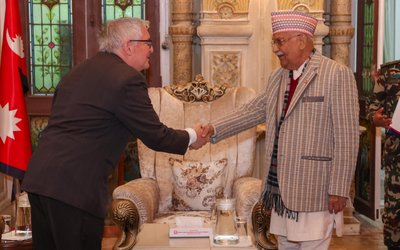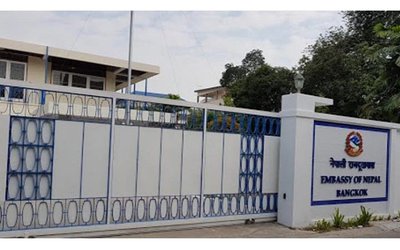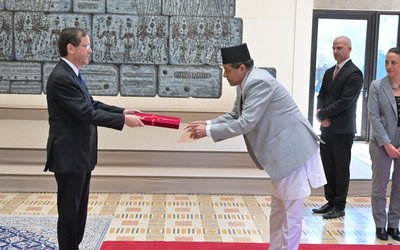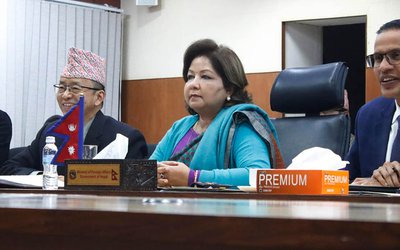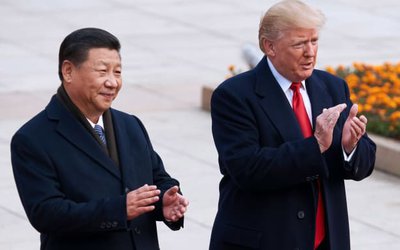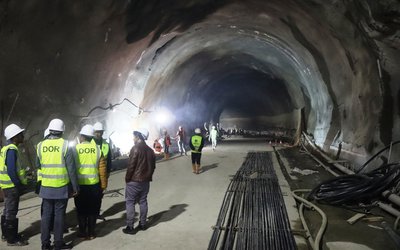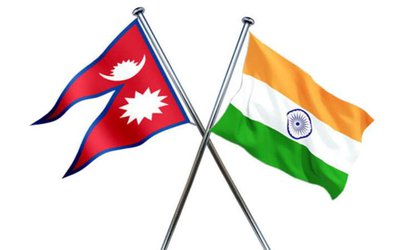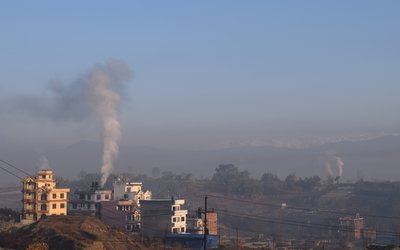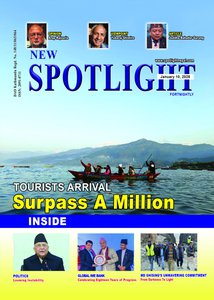
Everyone who goes around Baluwatar can notice Nepal’s Rastra Bank and the residences of the Prime Minister and Chief Justice. However, only a few realize that there is a big chunk of land behind historical Subarna Mahal or Lalita Niwas.
Surrounded by the residences of Nepal’s top authorities and Nepal’s Central Bank, the big open land, which has now landed in district land office, is on the verge of vanishing.
Under a petition filed by a petitioner, Advocate Yubaraj Koirala, Kathmandu District Land Office issued an order, prohibiting all the construction until the settling of land ceiling issue.
According to Land Act 1964, the government can confiscate any land from individuals if it crossed the ceiling. In a city like Kathmandu, an individual can possess just 3 ropanies of land. As the case is in the jurisdiction of the court, no comment is in place here.
The open space of 135 ropanis (63615 square meters) used to be a garden, pond, yard and quarter house of the workers of Lalita Niwas or Subarna Mahal.
Lawyers question the decision to transfer the ownership of excessive land, which violates the land act ceiling. The cabinet cannot override the provisions of the law.
Nationalized by King Mahendra following the dismissal of an elected government in 1960, the decision to return the land to its owner Subarna Sumsher’s sons and family members was taken by an interim government led by Krishna Prasad Bhattarai on 28 May 1990.
Along with Subarna’s property, the cabinet also passed a blanket decision, order to pass all the property to the rightful owners, whose property was confiscated by the government. The cabinet decision also gave amnesty to all the politicians who were in prison under the Panchayat Laws.
However, the cabinet decision has also made it clear that the decision cannot change the status of property owned by the government of Nepal, including Nepal Rastra Bank and the residences of PM, Chief Justice and erstwhile Raj Sabha chair and now Speaker.
With the application of son and grandsons of Subarna Sumshers including son Rukma Sumsher, grandson Hemdary Sumsher, son of Kanak Sumsher and grandson, Atak Sumsher, son of Kanchan Sumsher, the government issued an order to return the 135 ropanies of land, which was under the supervision of Sumer Jung Adda.
However, the process was delayed as Chait Narayan Maharjan, with 173 other tenants filed a petition, demanding to restore their rights in the land in Kathmandu Appellate Court in 1997. In 2000, the appellate court gave a verdict in favor of tenants.
As per the court order, landowners agreed to provide tenants their rights in 135 ropanies of land. After the clearance from the court, Kathmandu’s big land-brokers entered the scene to purchase the land.
With the release of land by a cabinet led by then CPN-UML leader Madhav Kumar Nepal's decision in 2010, Bhatbhateni Supermarket owner Min Bahadur Gurung, Tourism entrepreneur Ram Kone, Non-Resident Nepali Association (NRNA) and others bought the land. Bhatbhateni has already constructed a warehouse and Non-Residential Nepali Association (NRNA) is building an office within 18 ropanies of land. They bought the land from landowners in a compromise deal with tenants.
According to records of Kathmandu Land Reforms Office’s registration record, the families of Subarna Sumsher sold the land to many people in various plots.
According to the sources, the landowners and tenants sold the land for an average of 2.6 million rupees per ropani (5476.16 Square foot) in 2010. Currently, It cost not less than 80-90 million for the same land.
Disputes of Ceiling
The disputes appeared soon after. Upon a petition filed by advocate Koirala, the District Land Office issued an order to maintain the status quo in the area. This halted the construction spree. After the order, Kathmandu Metropolitan City issued an order to NRNA to stop the construction work.

NRNA filed a petition in Supreme Court seeking permission to continue construction on condition that they would abide by the final verdict. Supreme Court issued an interim order to Kathmandu Municipal City, directing it to allow the construction on the condition that NRNA should give a written letter with consent to follow the decision of pending petition on the ceiling issue.
Despite the interim order of the court, KMC is yet to give a clearance for the construction. However, NRNA continues to construct its building. As the dispute on the land is in the land office, the vast area of remaining land is now being used as a dumping ground of demolished houses and sewer water.

Till the opening up of a double-lane road from Speaker’s Residence connecting it to the Chief Justice’s residence in 2010, with the permission of Hemaduri Rana, the vast portion of land was covered by bush and stalk of the grass in a marsh or low land.
How this happened
The decision to return the land of Subarna Mahal to the owners raised the fundamental legal question, particularly about the land ceiling set by Land Act 1964. The act clearly sets the land ceiling.
Although the land was confiscated in 1961 under a Special Order, the new law promulgated with a provision of a land ceiling in 1964. Land Act 1964 fixed the ceiling on ownership of the land holdings as 25 Bigha (17 hec.) in Terai and inner Terai, 80 Ropanis (4.07 hec.) in the Hills and Mountains and 50 Ropanis (2.5 hec.) in Kathmandu for the purpose of farming. For residential purposes, one can hold only 3 ropanies of land in Kathmandu.
Besides, Nepal’s ownership of land is governed by Tenure Rights Protection Act (1951), Formation of Land Reform Commission (1953), The Land Act (1995), Land of Cultivators Record Act (1954), Birta Abolition (1959), Land Reorganization Act (1962), and Land Act (1964)
However, the Land Act (1964) is a cumulative outcome of previous efforts to transform the socio-economic structure of the society by altering the institutional structure of land and agriculture. This is the loophole where many landowners manipulated to retain all of their lands.
Lalita Niwas Land Deal
With the loopholes in the land act, one can easily escape the provisions of a ceiling. Individuals can keep the land as much as they can in the name of industry and landowners can get permission to divide the land later for residential purposes. Lalita Niwas Property is not an exception.
“If the deal was made for such a big chunk of land, it is all illegal. Even the cabinet cannot make a decision override the existing law,” said advocate Sitaram Dahal.

“As there are many flaws and loopholes, in fact, it gives space for politicians, landowners, and land dealers to misuse it. Although the one clause of land act bars to return all the land, another provision permits the landowner to own as much as he can for industrial purposes. This is where big landowners save their land placing it for industrial purposes,” said Dahal.
The whole episode of Lalita Niwas exposes how landowners, government officials, property dealers, court, and politicians make impossible deals possible entering the deal through the loopholes in the act.
Once the landholders, property dealers, muscle men, politicians and government officials come together, nothing is impossible in Nepal. With so many ambiguities, the land deal cases always reach into the court and court decision mostly favors the landowners.
Land in Nepal is an unsafe sector. Although Land Act 1964 guaranteed the right of landowners and tillers and made a system of land recording and field recording, there are many flaws as well. In the words of senior advocate Badri Bahadur Karki, there are two kinds of people running behind the land, one with the documents to find the public land and the other with land without the documents. Everyone can claim the public land.
How Was It Possible?
Under a cabinet decision in 1990, taken by the interim government led by Krishna Prasad Bhattarai, the owners secured the land ownership and clearance from the government and sold them immediately.
After earthquakes, a group of local people launched a campaign to save the open space of Baluwatar. The group has disappeared now. This scribe made several efforts to contact them, all went vain.
At a time some civil society groups are raising the questions on Nepal Army, Police and other government offices regarding the constructions in public open spaces, nobody speaks about this controversial deal with any reason. As most of the residents of the areas are newcomers, only a few people know about the beauty of courtyards.
Dr. George Varughese who is a local resident of the area has seen the rapid deterioration of the micro-ecosystem in the last few months. “It used to be an environmentally friendly space, like a wetland, with giant grasses and waterfowl. The wastewater flowing through it provided great conditions for flora and fauna to thrive. It functioned as both lungs and kidneys for this part of Kathmandu. Hundreds of local residents took refuge in the open space of this wetland following the 2015 earthquakes. In the past few months, I have seen the water dry up because of blocked waterways, dumped garbage and chemical waste, and construction. The giant grass is dying and birds are rarely seen. Instead, I can see a lot of trucks dumping waste at all hours of the evening and night. Does anyone care?” Varughese told to a talk program hosted by Sagarmatha Radio with the Urban Development Minister.
Why Only Subarna Mahal?
This plot of land became commercially attractive only after opening the two-lane road. “Although families of Subarna Sumsher Rana made several efforts to release the land when Girija Prasad Koirala was Prime Minister, Koirala, knowingly or unknowingly, did not release it,” senior Nepali Congress leader and minister for long with Koirala told New Spotlight on condition of anonymity. “They also requested me to convince Koirala that they will provide a necessary fund to build NC Central Office.”
Prime Minister Bhim Sumsher constructed it for his dear son Hiranya Sumsher, an heir for Rana Prime Minister and grandson Subarna Sumsher. Lalita Niwas was in fame.
Eighty-five years old Krishna Lal Maharjan, (not real name) who doesn’t want to be identified, recalled the days when he used to hear different birds and see some Ranas killing cranes and wild ducks there. “The land was so big and dense with trees and bushes, we rarely walked there,” said Maharjan, who has been living there for long. “My father used to say that Bhim Sumsher grabbed all these lands evicting the people by force in early 1926,” recalled Maharjan. “It is unfortunate democratic leaders handed over the land which used to be under government’s control till the Panchayat days.”
Along with Subarna Mahal, King Mahendra nationalized many Rana Palaces of Kathmandu and some even nationalized during the Rana period as well. However, only Subarna’s family got their property returned.
Having political influence at all levels of Nepalese system, Subarna’s family found easy access. Other Ranas whose property was also confiscated in the past blamed themselves for not having an influence.
At a time when many Ranas, including Purushotam Sumsher Rana, grandson of Rudra Sumsher, who was expelled by Juddha Sumsher confiscating all the property of Kathmandu, including the Char Burja, present Bahadur Bhawan, did not get anything returned despite his families’ involvement in the anti-Rana movement. But the return of the vast property of Subarna Sumsher families violated the ceiling provision is another interesting matter.
Save all the time
Although King Mahendra confiscated the property of Subarna Sumsher, officials did not transfer the property to the name of government in the paper. Whether it happened knowingly or by some slips, Subarna Mahal and its areas, including four government buildings of Ward No 4, are not listed in open spaces of Kathmandu, declared by the Ministry of Urban Development and Kathmandu Valley Development Authority even recently.
Although the vast areas behind Nepal Rastra Bank or a part of Subarna Mahal or Lalita Niwas still lie open, they do not appear in the recent list of open spaces. Prepared by NSET in 2011 and published by Ministry of Urban Development and Kathmandu Valley Development Authority in 2015, Atlas of Open Spaces in Kathmandu Valley, an Inventory Mapping and Open Spaces in Kathmandu Valley, identified a total of 887 open spaces in Kathmandu Valley. Out of them, 488 open spaces are in Kathmandu alone.
The mapping does not consider spaces around the Subarna Mahal, including the Prime Minister’s residence, chief justice’s residence and Nepal Rastra Bank as open. The map includes all the open spaces owned by the government like Singha Durbar, Narayanhiti Palace, Keshar Mahal, private and public school buildings, religious sites.
When asked, Surya Bhakta Sagachhe, former head of Kathmandu Valley Town Planning Authority and technical expert of National Society for Earthquake Technology (NSET), have considered using the big plot behind Nepal Rastra Bank. “One reason could be that the land has already been fragmented into several small plots,” Sangachhe told New Spotlight.
Govinda Acharya, ward secretary of Ward no 4 of Kathmandu Metropolitan City, said that the land is owned by individuals. “We cannot declare the piece of land as open space because it is in court. We have already issued orders not to construct any building on the site.”
No Trust
As the land officials have earlier cleared the land without looking at the ceiling provision, people have doubt that the officials act again as per the land ceiling prescribed by law.
At a time when politicians, government officials, and land brokers have combined power, nothing can change. Those who bought the land too know that they will secure their investment sooner or later.
By continuing its construction work, NRNA has shown its confidence over the decision. Similarly, Bhatbhateni has also built the warehouse.
“If there is a violation of law, the government will follow the law,” said Punya Vikram Paudel, information officer, Ministry of Land Reforms. So far as a land ceiling is concerned, the land act is clear on that.
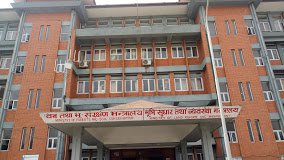
The only way the government can save the open space is to pay compensation and control the land on its own. At a time when the politicians are leasing property through under-the-table deals, there is little hope that they will take such a decision.
So far as civil society and community are concerned, they are helpless in front of money, muscle, and power.
Beauty of Subarna Mahal
As Subarna’s families sold the land, Nepal Rastra Bank decided to demolish the Subarna Mahal or Lalita Niwas, which was built in 1930 and reconstructed after 1934 earthquake by Chief Engineer and Lieutenant Colonel Dilli Jung Thapa, the traces of a history are going to go away. According to archeologist and historian Dr. Safalya Amatya, “one of the best parts of Subarna Niwas is its garden, which is very beautiful, with big ponds. It was one of the unique palaces with garden built by Bhim Sumsher Rana to his dear son Hiranya Sumsher Rana, who went to exile in Kolkata, with his sole son Subarna Sumsher in 1936.

Out of many palaces built by Bhim Sumsher, Bishal Nagar Durbar, Satya Bhawan, Tangal Durbar, Sita Bhawan, Baluwatar Durbar and Subarna Mahal, the palace of Subarn Mahal was famous for its ponds and gardens.
“Lying in the courtyard of Nepal Rastra Bank, only a part of the garden is now present, but the big ponds and other areas are gone. Situated in Baluwatar, occupying a vast stretch of land, Subarna Mahal is one of the beautiful Rana Palaces,” writes Dr. Safalya Amatya, in his article in Ancient Nepal. “Built around three Courtyards, one of the courtyards is used by Nepal Rastra Bank. Constructed in 1930 and renovated after the earthquake of 1934, which had completely damaged Subarna Mahal, a large area which consisted of ponds, garden and lanes is in the process of vanishing.”
According to the historical records, Subarna Mahal or Lalita Niwas expanded in the areas of 399 ropanies (203060 square meters). Out of this prime minister’s residence, Nepal Rastra Bank, Chief Justice residence and speaker’s residence occupy 100 ropanies (6000 square meters). Archeologists Carl Pruscha in his book mentioned the beauty of the palace.
Not only, Subarna Mahal, all the grand palaces of Ranas stood at the center of vast expanses of landscaped grounds confiscated from the people to show their supremacy over the common people.
After the overthrow of the Rana Dynasty, some palaces were converted into government buildings. Others were demolished by their owners and rebuilt into libraries, museums, hotels, and heritage complexes. Most palaces, still in private ownership, have been destroyed or lie in ruins. Even the government-owned palaces have been in critical conditions and some of them are already leased out.

Although Nepal’s civil society members criticize the ongoing construction of a new building by the Nepal Army, no voice is there to oppose the palace issue.
A group that is active on Facebook for the conservation of heritage sites, ‘Save Heritage’, had submitted a petition to stop the construction in other public places. There are rare people, however, to voice for Lalita Niwas preservation, which is going to be a history soon.

Baluwatar's land

Lalitaniwas

The Palace destroyed by earthquake

Keshab Poudel
Poudel is the editor of New Spotlight Magazine.
- The Question Arises: Do Former Prime Ministers Prachanda, Nepal, And Dr. Bhattarai Support The Terror actions Of Hamas?
- Dec 11, 2024
- MD KUL MAN GHISING: December 25 Deadline For Upper Tamakoshi
- Dec 09, 2024
- ADB's REFP Reintegration of Returnee Migrants
- Dec 02, 2024
- The Relationship Between Kosovo And Nepal Is Robust: ELBERT KRASNIQUI
- Nov 29, 2024
- ADB’s REFP: Women (Em)Power
- Nov 28, 2024


